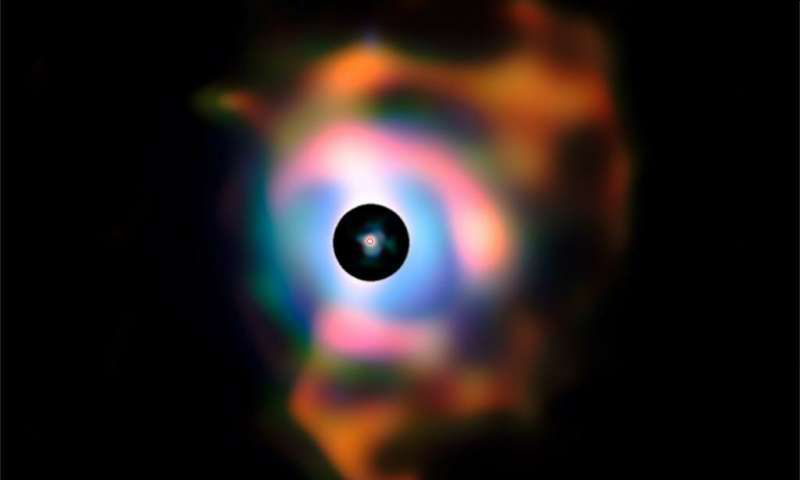Birth of Betelgeuse Supernova
by Harley White
- Published: Wednesday, February 26 2020 04:08

Betelgeuse has gotten brighter and dimmer
for more than a century it’s been remarked.
But now it seems to be barely a glimmer
compared to its brilliance before, which has sparked
a host of astronomers in a flurry
to speculate on what could be the meaning.
Is this red supergiant in a hurry
to end its life stellar and go careening
off into supernova spectacular,
although such an astral explosion immense
was not predicted by mode oracular
in terms of prevalent scientific sense
for perhaps tens of thousands of years at least?
Researchers are seeking the explanation
as to why luminosity’s so decreased
in this recent peculiar fluctuation.
The tag supergiant’s indeed justified
apropos of supposed sidereal size
that’s between Mars and Jupiter’s orbits wide,
with a mass nearly twelve times our sun’s likewise.
Multiple factors could be interacting
with respect to so much ambiguity,
such as, its radiance might be impacting
telescope scrutinizing acuity.
The star’s merely thirty-six percent in glow
when compared to a year heretofore as seen,
caused perhaps by dust cloud from astral outflow
or an area cooled that’s lessened its sheen.
It also looks odd, besides diminishing,
revealing an oblong, lopsided physique,
which further blurs when it will be finishing
and adds to the aura of stellar mystique.
A semi-regular variable star,
most cycles while differing were expected,
but the current faintness set notions ajar
due to deviating data collected.
In Orion constellation it resides
wherein Betelgeuse a million years ago
left the main sequence of evolving star tides
to become the red supergiant we know.
For about forty thousand years it has had
that distinction and so eventually
when it burns enough hydrogen to go mad
a collapse will occur consequentially
of the core followed by outburst tremendous
that will light the firmament in a grand way,
beaming for months with a gleam so stupendous
to be visible even during the day!
After six years of supernova display,
we won’t perceive Betelgeuse with naked eye,
hence Orion’s outline will change in array
which many stargazers lament with a sigh.
Since its name signifies ‘shoulder of giant’,
some say they will miss the change in appearance
when Hunter’s aspect, on which are reliant
lots of sky watchers, lacks present coherence.
Of course by the time those events come to pass
who knows who the heavens’ beholders will be,
or if earthly species, endangered, alas,
will have perished, as might heedless humans we?
In the meantime, due to layers it’s shedding
a nebula stunning is being designed
with spectacle flamelike around it spreading,
showing death and transfiguration entwined.
Thus as Betelgeuse is becoming fainter,
in the process it’s being recreated
as if by the brush of a cosmic painter
in a new portrayal for which it’s slated.
A heritage it will be leaving behind
to rejuvenate the stelliferous sphere,
perchance with revival of wiser Mankind,
will be sprinkles of stardust from yesteryear.
Because it is seven hundred light-years far
from Earth, observations can only descry
what, six hundred years in the past on that star,
occurred, so though unlikely, maybe on high
already is shining that sight projected
from birth of a supernova resplendent,
six centuries later to be detected,
Betelgeuse’s long-awaited descendant!
~ Harley White
* * * * * * * * *
Sources of inspiration and information were too many to enumerate, so I am only listing two that relate to the image posted with the poem…
Betelgeuse continues to dim, diminishes to 1.506 magnitude
https://phys.org/news/2020-01-betelgeuse-dim-diminishes-magnitude.html
Image ~ Nebula around Betelgeuse
https://en.wikipedia.org/wiki/File:Nebula_around_Betelgeuse.jpg
This picture of the dramatic nebula around the bright red supergiant star Betelgeuse was created from images taken with the VISIR infrared camera on ESO’s Very Large Telescope (VLT). This structure, resembling flames emanating from the star, forms because the behemoth is shedding its material into space. The earlier NACO observations of the plumes are reproduced in the central disc. The small red circle in the middle has a diameter about four and half times that of the Earth’s orbit and represents the location of Betelgeuse’s visible surface. The black disc corresponds to a very bright part of the image that was masked to allow the fainter nebula to be seen.
Credit: ESO/P. Kervella







Comments